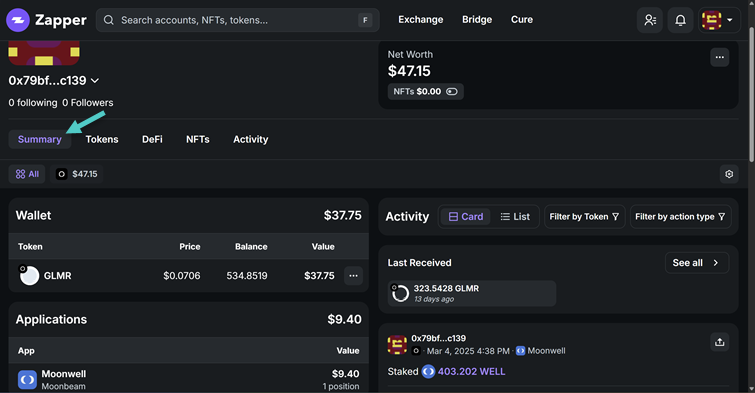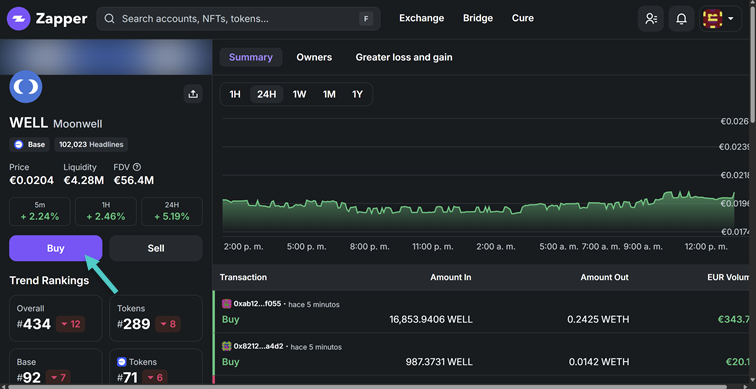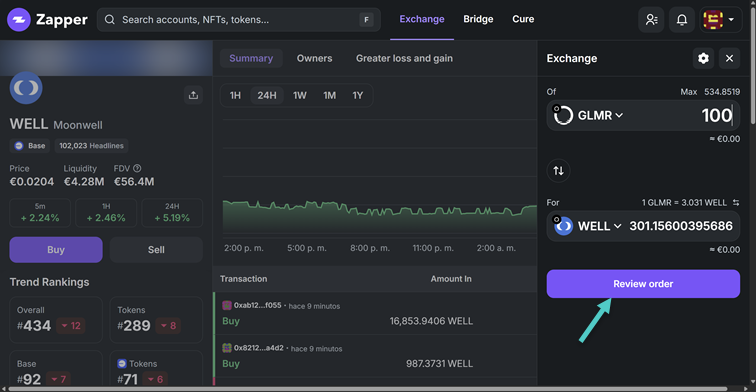Portfolio Tracking with Zapper¶
Introduction¶
Zapper is a Web3 application that enables users to explore on-chain data, manage their portfolios, and interact with decentralized finance (DeFi) protocols across multiple networks, including Moonbeam. Through their integration with Zapper, users can monitor and manage assets across Moonbeam’s DeFi ecosystem, including platforms such as Moonwell, StellaSwap, OmniLST, and Prime Protocol.
This tutorial provides a detailed step-by-step guide for users and developers to integrate with Zapper and maximize their experience within the Moonbeam ecosystem.
Get Started on Zapper¶
You can navigate to Zapper's official website and take the following steps to start interacting with the application:
- Click on the Connect Wallet button at the top right corner
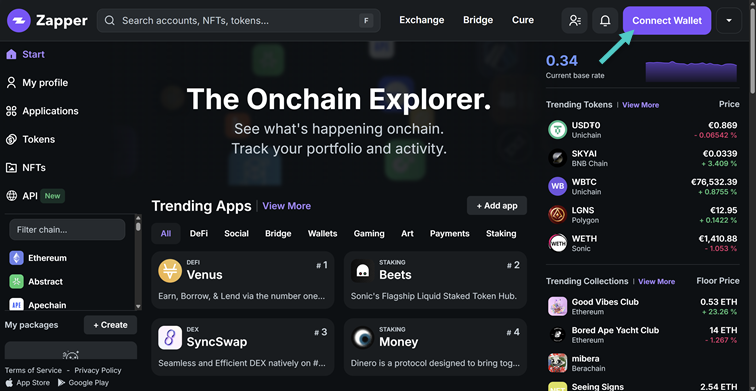
- Select your preferred wallet from the supported options (e.g., MetaMask, Talisman, Coinbase Wallet)
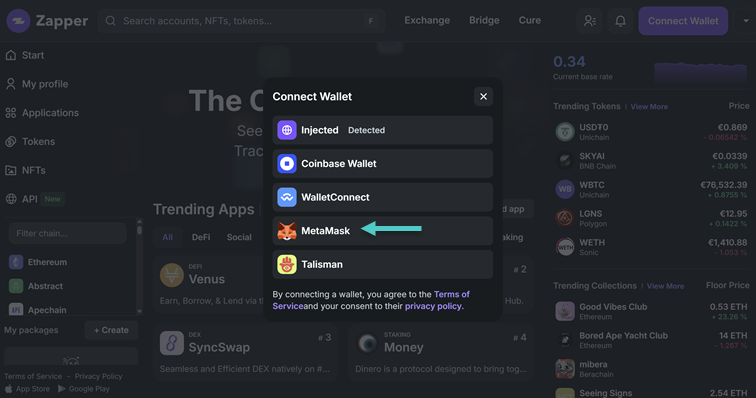
- Follow the on-screen prompts to connect securely to Zapper
Explore Your Portfolio¶
Once your wallet is connected, Zapper will automatically detect and display your assets across supported networks, including Moonbeam. You can navigate to your main dashboard by clicking on My profile on the left sidebar or selecting it from the wallet icon on the top-right corner. The dashboard provides an overview of your holdings and activity split in the following categories:
- Summary - displays your total assets, liabilities, and net worth across all networks
- Tokens - lists all tokens held in your connected wallet, including GLMR (Moonbeam's native token) and any ERC-20 tokens
- DeFi - shows active positions in Moonbeam-based DeFi platforms such as lending, liquidity pools, and staking
- NFTs - displays any NFTs you own on Moonbeam or other supported chains
- Activity - Zapper's dashboard provides real-time data, enabling efficient management of your on-chain activities
Engage with Moonbeam's DeFi Ecosystem¶
Zapper provides access to view the activity on Moonbeam's DeFi protocols, such as:
- Moonwell - for accessing lending and borrowing services
- StellaSwap - for participating in token swaps and liquidity provision by depositing token pairs into StellaSwap's liquidity pools
- OmniLST - for engaging in liquid staking opportunities (stake GLMR tokens to receive liquid staking tokens and use them in other DeFi applications)
- Prime Protocol - for managing cross-chain assets and accessing borrowing services (deposit assets as collateral to borrow across multiple chains)
You can follow these steps to review any of the aforementioned protocols:
- Select Moonbeam from the chain filter in the left sidebar. This will display the most trending dApps in the ecosystem. Click on the protocol you wish to explore
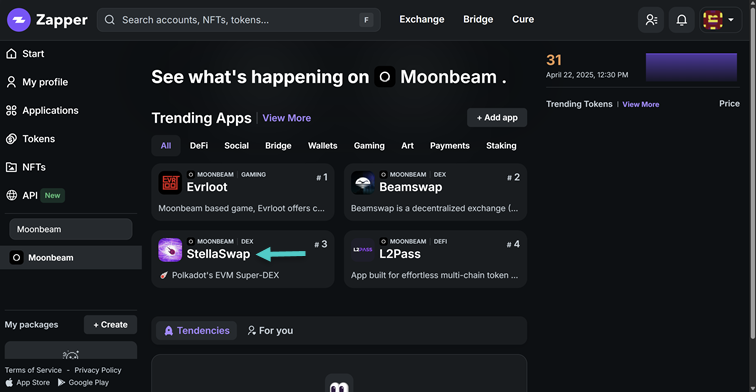
- In the Activity tab, view the latest transactions for the selected protocol, including token swaps, LP or staking on StellaSwap, lending and borrowing on Moonwell, staked GLMR on OmniLST, and activity on other supported dApps
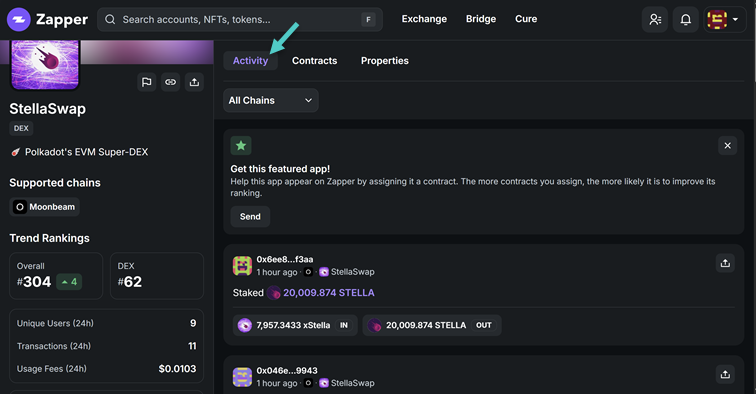
- View additional details for the selected protocol, including daily active users and daily transactions in the left sidebar, deployed smart contracts in the Contracts tab, and your holdings in the protocol via the Properties tab
Access and Manage Moonbeam Assets¶
Zapper also has an integrated modal for seamlessly swapping assets on Moonbeam. You can access this feature by selecting Moonbeam in the chain filter on the left sidebar and choosing the desired token on the right sidebar.
Inside the token page, you'll be able to see the asset's performance and details such as price action, volumes, holders and transactions.
To perform a swap you'll need to access the swap modal by clicking on the Buy/Sell buttons in the left sidebar. Once inside the modal you can select the assets for swapping, input the desired quantity for the token you want to sell, and click on Review order to sign and submit the transaction.
Integrate with Zapper's API¶
Developers can leverage Zapper's API to enrich their applications with comprehensive DeFi data from the Moonbeam network.
You can register for an API key by visiting the Zapper API portal. An API key is necessary to authenticate your application and access Zapper's endpoints.
Zapper offers several endpoints to fetch relevant data, such as:
- Balances - retrieve asset balances for addresses on Moonbeam
- Transactions - access transaction histories
- Prices - obtain real-time token prices
Furthermore, you can familiarize yourself with the Zapper API documentation, which provides detailed information on the available endpoints, request structures, and response formats.
Depending on your preferred programming language, you can set up your environment to make HTTP requests to Zapper's API. Below is an example of retrieving token balances for a specified wallet address on Moonbeam using Node.js and Axios:
const axios = require('axios');
const API_KEY = 'INSERT_API_KEY';
const address = 'INSERT_WALLET_ADDRESS';
const chain = 'moonbeam';
axios.get(`https://api.zapper.xyz/v1/protocols/tokens/balances`, {
params: { addresses: address, network: chain },
headers: { Authorization: `Bearer ${API_KEY}` }
})
.then(response => {
console.log(response.data);
})
.catch(error => {
console.error(error);
});
Note
Ensure that your application handles API responses appropriately and includes error-handling mechanisms.
By following this tutorial, users and developers will have effectively learned how to integrate with Zapper and use it for exploring multiple DApps in the Moonbeam network.
Additional Resources¶
You can also explore the Zapper API GitHub repository for code examples and community contributions, or refer to Zapper's integration guides for detailed instructions and best practices.
| Created: March 4, 2025
